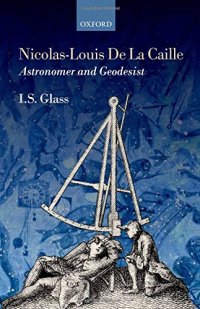
Ebook: Nicolas-Louis De La Caille, Astronomer and Geodesist
Author: Ian Stewart Glass
- Tags: History Africa Americas Arctic Antarctica Asia Australia Oceania Europe Middle East Russia United States World Ancient Civilizations Military Historical Study Educational Resources Reference Test Preparation Almanacs Yearbooks Atlases Maps Careers Catalogs Directories Consumer Guides Dictionaries Thesauruses Encyclopedias Subject English as a Second Language Etiquette Foreign Genealogy Quotations Survival Emergency Preparedness Words Grammar Writing Research Publishing Philosophy Science Math Ma
- Year: 2012
- Publisher: Oxford University Press
- Edition: 01
- Language: English
- pdf
La Caille was one of the observational astronomers and geodesists who followed Newton in developing ideas about celestial mechanics and the shape of the earth. He provided data to the great 18th-century mathematicians involved in understanding the complex gravitational effects that the heavenly bodies have on one another.
Observing from the Cape of Good Hope, he made the first ever telescopic sky survey and gave many of the southern constellations their present-day names. He measured the paths of the planets and determined their distances by trigonometry. In addition, he made a controversial measurement of the radius of the earth that seemed to prove it was pear-shaped.
On a practical level, La Caille developed the method of `Lunars' for determining longitudes at sea. He mapped the Cape. As an influential teacher he propagated Newton's theory of universal gravitation at a time when it was only beginning to be accepted on the European continent.
This book gives the most comprehensive overview so far available of La Caille's life and work, showing how he interacted with his often difficult colleagues. It places special emphasis on his life at, and his observations and comments on, the Cape of Good Hope, where he spent the years 1751-53.
Observing from the Cape of Good Hope, he made the first ever telescopic sky survey and gave many of the southern constellations their present-day names. He measured the paths of the planets and determined their distances by trigonometry. In addition, he made a controversial measurement of the radius of the earth that seemed to prove it was pear-shaped.
On a practical level, La Caille developed the method of `Lunars' for determining longitudes at sea. He mapped the Cape. As an influential teacher he propagated Newton's theory of universal gravitation at a time when it was only beginning to be accepted on the European continent.
This book gives the most comprehensive overview so far available of La Caille's life and work, showing how he interacted with his often difficult colleagues. It places special emphasis on his life at, and his observations and comments on, the Cape of Good Hope, where he spent the years 1751-53.
Download the book Nicolas-Louis De La Caille, Astronomer and Geodesist for free or read online
Continue reading on any device:

Last viewed books
Related books
{related-news}
Comments (0)